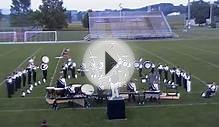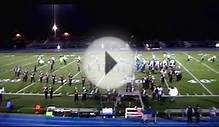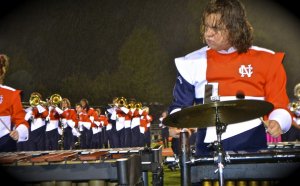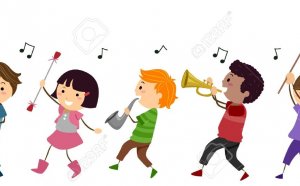
Marching Band field Show Music
You are Here: Archived Articles and Videos » Marching Band » Composer’s/Publisher’s Thoughts About Field Show Music Selection - Part 2
A Composer’s/Publisher’s Thoughts
About Field Show Music Selection - Part 2
2009 Drill Design
Steve Martin,
V.P. of Gary P. Gilroy Publications, Inc.
For band directors, one of the most challenging and important decisions for any aspect of a band program is selection of repertoire. In the fall, this decision becomes increasingly daunting given that so many factors must be weighed against each other, not to mention its 6-7 minutes of music to be stuck with for several months! Once the decision is made to use pre-written or arranged music (that decision belongs in another article), choosing the show music should be done with great deliberation by all people involved in the design of the final production. Collaboration and buy-in at this initial stage of design will greatly enhance the quality of the final product. Below are several key factors that we recommend band directors and their personnel consider carefully before deciding on music for marching band.
1. Educational value/purpose: Hopefully, this is a chief concern to any band director. Marching band should be educational as well as functional, so one should find music that is a good fit with the level of each program and year while still providing opportunities for growth. For example, if an ensemble struggles with triple-meter, consider music that has a section in 6/8 or 12/8. This would afford the opportunity to focus on a musical element that needs improvement while maintaining success in the other sections of the music that feel comfortable to the ensemble. Conversely, avoid a jump to an entire show of 9/8, 7/8 and other advanced metric infusions, as this would most likely prove frustrating. Other musical elements that can be considered include texture, tonalities, or extreme tempi. As all of these elements are considered, it is possible to benefit from the massive amounts of repetition associated with marching band by reinforcing a concept that is lacking in a program’s musical foundation.
2. Entertainment value: One of the great debates in the world of pageantry today is surrounding the artistic vs. entertainment value of today’s marching band, winter percussion, winter guard and drum corps productions. When it comes to high school marching band, entertainment value must be a consideration. The most important aspect of live performance is providing an opportunity for performer and audience to connect. It is certainly possible to educate through marching band (as discussed above) without trying to put the great works of symphonic and wind band literature on the field. Always be careful to consider selecting music that will resonate with your audience, which is usually parents, home football crowds, other students, and, of course, adjudicators. This is a difficult balance to achieve, but a band that plays a perfect show that is beyond the comprehension of most of its audience will often be left unfulfilled as they fail to make a connection. Music with a theme or program is often most likely to promote achievement of this concept, as audiences only have a few minutes to connect and understand what the band is trying to communicate, and a theme provides a common ground or starting point. A theme is not essential, but usually a simpler avenue towards connection.
3. Competitive value: In line with the comments on entertainment value, a true win-win occurs when a very entertaining show contains elements that lead to success in competition. This requires a high level of coordination of all elements, but often begins with a well-integrated musical book. There must be ample opportunities for the visual designer to use musical elements as a means for visual progression and development. Here is a short list of key items to look for:
a. Balanced and appropriate usage of all voices, including battery and front-ensemble percussion.
b. Appropriate density of scoring, keeping an eye out for 4-part voicings in trumpets or low brass.
This is not always bad, but can present challenges for smaller ensembles.
c. Appropriate ranges for all instruments
d. Pacing of the musical impacts. The music needs well-spaced “ups and downs” to enable the
visual package to develop in tandem.
4. Financial value: Once the decision to use pre-written music is made, there is a large discrepancy in pricing, from as low as $60 per piece/song to upwards of $2000 for an entire show. Ironically, the price tag does not always reflect the quality of the music. It is possible to select 3-4 songs from the “New for Marching Band” catalogs and be very effective in all of the categories above. It is also possible to spend $1500 and purchase music that is not going to provide the correct opportunities for a particular ensemble. Obviously, budget becomes a factor and each program must determine what they are capable of and work within that sphere. It is important to consider what other options one may have that are either included or optional with certain companies. For example, some companies provide SmartMusic files that can be invaluable tools for students as related to their individual practice. Various types of regional or site based exclusivity help to ensure that music will not be repeated several times in front of the same audience (including the adjudication panel). Optional drill, choreography and other collateral materials may also be available. Whether or not one or any of these are important to a particular program, they should be factored in to the overall financial value of the show music selection.
The above list is by no means exhaustive. It is a general guideline of key factors to consider. Most importantly, fall music, by its very nature in competitive marching band programs, is a long-term commitment, so it must be something that will fit well and resonate with each particular program. It doesn’t matter if the band down the street won first place all year with a piece of music or show concept. It only matters if the band playing that music can enjoy it and buy in to it. However, once that decision is made with care, the ensuing months of labor and end result are something to cherish and build upon into the spring.
YOU MIGHT ALSO LIKE


Share this Post
Related posts
Marching Band Stand Music
Turn on any college football game this season and you re bound to hear the White StripesSeven Nation Army,which in the past…
Read MoreMarching Band Music
Please learn, memorize and be comfortable with the exercises and rudiments in this packet. These exercises and rudiments…
Read More










